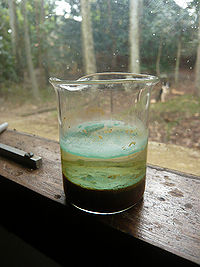Project:Deactivating a ferric chloride solution
Project maintained by Daniel Sikar ~/ dsikaratgmaildotcom.
Deactivating a ferric chloride solution
In practice
- Example
A solution that was made with a packet of ferric chloride (FeCl3) crystals weighing 300 grams requires 222 grams of sodium hydroxide (NaOH) to be deactivated.
After deactivation, the neutralised solution will contain iron hydroxide (Fe(OH)3) which is rust and sodium chloride (NaCl) which is common table salt.
Both are innocuous and can be poured down the drain.
- Method
Pour the spent ferric chloride solution in a plastic bucket - do not use metal buckets, add about 5 times its volume of water. Dissolve 222 grams of sodium hydroxide in about 3 litres of water.
In a thin stream, add the sodium hydroxide solution to the ferric chloride and stir. Once it turns rust coloured it is ready to be discarded.
If not discarded, on standing, the iron hydroxide will separate out at the bottom, while at the top, a crust of copper carbonate (CuCO3) will form due to the copper from etched circuits.
The iron hydroxide at the bottom is a standard commercial pigment and can be separated off the solution and added to latex paint.
In Theory
Ferric chloride reacts with sodium hydroxide turning into ferric hydroxide and sodium chloride.
FeCl3 + 3 NaOH → Fe(OH)3 + 3 NaCl
The proportions are:
1 mole of FeCl3 which is 91,3g reacting with 3 moles of NaOH which is 120g.
The mass of 1 mole is obtained by adding together the atomic masses obtained from the periodic table of elements:
Iron (Fe) has the atomic mass of 55.8 (grams/mole) and Chlorine (Cl) has the atomic mass of 35,5 (grams/mole).
Ferric chloride (FeCl3) will then have the molecular mass of 55.8 * 1 + 35.5 * 3 = 162.3 g/mole.
To find how many moles are contained in 300 grams of ferric chloride the calculation is 300/162.3 = 1.85 moles of ferric chloride.
Conversely; Sodium (Na) ~ 23 g/mole, Oxygen (0) ~ 16 g/mole and Hydrogen (H) 1 g/mole totalling 40 grams per mole.
Each mole of FeCl3 requires 3 moles of NaOH (sodium hydroxide) at 40 grams per mole.
The weight of Na0H required to deactivate the spent FeCl3 solution is obtained thus:
1.85 * 3 = 5.55 moles of NaOH, at 40 g/mole that will be 5.55 * 40 = 222 grams NaOH.
